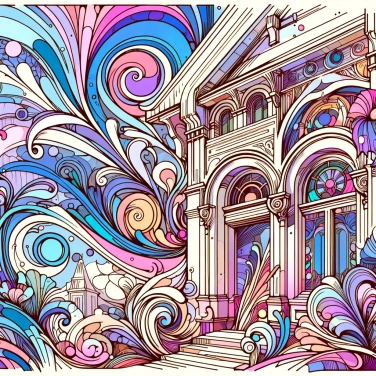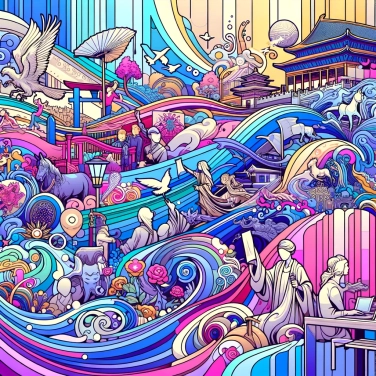Art Nouveau introduced organic forms inspired by nature in architecture and design to express a rejection of classicism and industrialization of the time, seeking to rediscover harmony with nature and promote originality and creativity.

In the mid-19th century, artists turned to nature to find examples of authentic beauty, away from the rigid styles of the past. They directly observed plants, flowers, and insects, using these inspirations in their creations. The botanical illustrations and scientific studies published at that time also played a significant role. Artists like Emile Gallé and Alphonse Mucha clearly drew from the plant world for their fluid patterns and harmonious curves. It was a true obsession with life, organic movement, and natural forms, breaking completely from the strict traditions of the past.
Faced with the rigidity of classicism and the coldness of industrialization, the creators of Art Nouveau chose to do something different. Instead of austere geometric lines, they sought fluid forms, inspired by the soft and vibrant curves of nature. The same goes for industry, which imposes the same thing everywhere: in the face of repetitive and standardized industrial productions, artists prefer handmade, unique objects that reflect a true sensitivity. The idea was clearly to bring a little life and poetry back into people's daily lives through warmer creations that are closer to nature.
At that time, thinkers like John Ruskin and William Morris were questioning a lot of things. For them, art and craftsmanship should draw directly from nature, and not simply copy old patterns already seen a thousand times. All these ideas gave rise to a new aesthetic, with natural curves and botanical motifs. Meanwhile, movements like symbolism placed personal sensitivity and imagination at the heart of artistic creation, proposing a poetic and sensitive vision of the world, far from the strict rules of the past. These theories would influence the artists of Art Nouveau, pushing them to incorporate even more organic forms, stylized flowers, or flowing lines into their architectural and decorative works.
The artists of Art Nouveau had the strong idea of breaking down the barriers between different arts: design, painting, sculpture, and architecture. In their eyes, everything should blend harmoniously into a coherent whole. They envisioned buildings as living organisms, where each element, whether a door handle or a staircase, contributes to the same aesthetic inspired by nature. This approach allowed them to offer a total artistic experience, integrated into daily life. One often finds in furniture, interior decor, or even the facades of buildings, plant motifs reminiscent of the fluid curves of plants or the movement of waves. Through this holistic approach, Art Nouveau aimed for a fusion of art, the built environment, and the natural world, to create a beauty that is simple and accessible to all.
At the end of the 19th century, Europe enthusiastically discovers Japanese art, a phenomenon known as Japonisme. Suddenly, Japanese prints with their fluid lines, vibrant colors, and minimalist simplicity become ultra-popular among European artists. These influences from the Far East push creators of Art Nouveau to abandon heavy and rigid Western forms in favor of a lighter, more refined, and harmonious style. They draw directly from nature, favoring plant motifs, elegant curves, and the asymmetry characteristic of Japanese art. This original blend of East and West allows Art Nouveau to offer an innovative and dynamic aesthetic that breaks away from outdated academic artistic codes, bringing freshness, poetry, and spontaneity to European architecture and design.
The facades of Art Nouveau buildings, such as those designed by architect Antoni Gaudí in Barcelona, are often created by imitating the curved lines of plants and the irregular shapes of nature, with very few straight lines.
Art Nouveau was profoundly influenced by Japanese printmaking, particularly the works of artists like Hokusai, whose stylized floral patterns and emphasis on natural forms greatly inspired European designers of the time.
Victor Horta, a Belgian pioneer of Art Nouveau, deliberately used wrought iron plant elements inside his buildings to create a strong symbolic and aesthetic connection between nature and architecture.
In reaction to the standardization and straight lines imposed by 19th-century industrial production, Art Nouveau sought to restore to craftsmanship and manual labor a central status that values the inspired and free gesture of the creator.
Yes, to a certain extent. Art Nouveau also serves as a critical response to the standardization and rigidity of increasing industrialization, seeking to reestablish an artistic and emotional connection with nature within the very framework of the modern urban environment.
Yes, notable examples include Antoni Gaudí's Casa Batlló in Barcelona with its fluid lines inspired by marine nature, and the Tassel Hotel designed by Victor Horta in Brussels, famous for its distinctive plant and organic motifs.
Japonism introduced an aesthetic to the West based on simplicity, asymmetry, and the stylized representation of nature. These characteristics inspired Art Nouveau artists to explore fluid and harmonious natural forms, differing from Western classical norms.
Although primarily European in origin, Art Nouveau had a global influence, notably reaching the United States in the form of the 'Tiffany' movement with its famous lamps and stained glass, as well as other countries like Japan and Argentina, each adapting the style to their local cultural contexts.
Art Nouveau frequently employs materials that allow for fluid curves, particularly glass, wrought iron, ceramics, and worked wood, in order to better express the organic shapes found in nature.
These movements share certain similarities but also have major differences. While Art Nouveau favors organic forms inspired by nature with curved and fluid lines, Art Deco, which emerged later, emphasizes geometric patterns, symmetry, and a more modern and streamlined style.

No one has answered this quiz yet, be the first!' :-)
Question 1/5